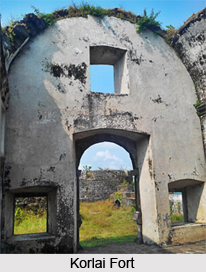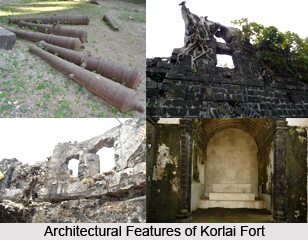 Korlai Fort is a fortification built by the Portuguese in the Korlai town of the Indian state of Maharashtra. It is popularly also known as Morro or Castle Curlew. The name Morro of the fort is derived from its location, as the fort stands on an island named Morro de Chaul. The way to the Revdanda Creek is guarded by it. Korlai Fort was constructed as a companion of the fort of Chaul, a former city of Portuguese India which is presently in ruins. The strategic position of the fort helped the Portuguese to defend foreign attacks in their province, which extended from Korlai to Bassein. Relics of Portuguese occupation can be traced in the unique dialect, known as Kristi, used in the Korlai villages by the inhabitants who are mainly Luso-Indian Portuguese Creoles.
Korlai Fort is a fortification built by the Portuguese in the Korlai town of the Indian state of Maharashtra. It is popularly also known as Morro or Castle Curlew. The name Morro of the fort is derived from its location, as the fort stands on an island named Morro de Chaul. The way to the Revdanda Creek is guarded by it. Korlai Fort was constructed as a companion of the fort of Chaul, a former city of Portuguese India which is presently in ruins. The strategic position of the fort helped the Portuguese to defend foreign attacks in their province, which extended from Korlai to Bassein. Relics of Portuguese occupation can be traced in the unique dialect, known as Kristi, used in the Korlai villages by the inhabitants who are mainly Luso-Indian Portuguese Creoles.
History of Korlai Fort
The Portuguese constructed the Korlai Fort in the year 1521 after receiving permission from the Ahmednagar Sultanate. After some prominent struggles between the Ahmednagar sultanate and the Portuguese, the fort remained under the possession of the premier till 1594 after which the latter succeeded in capturing it. Even after its capture by Portuguese, the Sultanate still tried to establish their possession over it by various means. Although the Portuguese managed to win it, they lacked soldiers to guard it and thus chose to demolish the whole fortification except a battery and the central tower. Some of its parts were later rebuilt. The church inside it earlier held regular worships on Sundays and holidays. The son of Shivaji, known as Sambhaji, once tried to capture it in vain. Later Korlai Fort came under the possession of Marathas from 1739 to 1818.
 Features of Korlai Fort
Features of Korlai Fort
Korlai Fort is about 2828 feet in length with an average breadth of 89 feet. The wall that encloses the fort is 5`3" high and it has 305 battlements for guns. There are 11 entry gates to the fort out of which 7 form the inner gates and 4 form the outer gates. There is a water cistern known as Santa Cruz at the northern part near the main battery, which formed the main source of water for the fort. The complete area inside the fort walls is divided by two lines of bastioned fortifications into three enclosures. The name of a saint can be found in each of the bastions. The names of the two bastions, westward, are Sao Francisco (after Francis of Assisi) and Sao Diego (after Didacus of Alcala). Other bastions are named as Sao Filipe, Sao Inacio and Sao Pedro. A large rain water cistern is also present having three mouths, each having a width of one foot. Ruins of a church and a magazine have also been found in the fort. The church was constructed in the year 1630 and was used by the army, it functioned till 1728.
Three Portuguese inscriptions have also been found in the fort. One of the inscriptions is surmounted by a cross having a coat of arms with Portuguese stars in the centre. Other inscriptions found over an altar in the chapel and the main entrance, have faded out and could not be deciphered. Changes were made to the names of the bastions during the brief Maratha rule. Certain dismantled shrines can also be witnessed in the fort as an evidence of the presence of Marathas.
Visiting Information to Korlai Fort
Chhatrapati Shivaji International Airport (120 km) and Pen Railway Station (50 km) are the nearest to visit the Korlai Fort. Korlai is well connected to cities and towns by road through National Highway 53.




